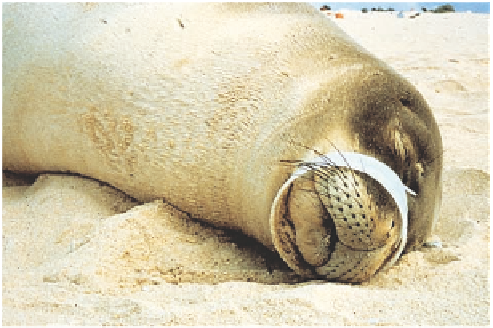Environmental Engineering Reference
In-Depth Information
the 60 USFWS inspectors can examine only one-fourth
of the approximately 90,000 shipments that enter and
leave the United States each year. Even if caught, many
violators are not prosecuted, and convicted violators
often pay only a small fine.
Science and Politics: Protecting Threatened
and Endangered Marine Species
We can use laws to reduce the premature extinction of
marine species.
The ESA has also been used to protect endangered and
threatened marine reptiles (turtles) and mammals (es-
pecially whales, seals, and sea lions). Each year plastic
items dumped from ships and left as litter on beaches
threaten the lives of millions of marine mammals, tur-
tles, and seabirds that ingest, become entangled in,
choke on, or are poisoned by such debris (Figure 9-19).
The world's eight major sea turtle species are en-
dangered or threatened (Figure 9-20). Two major
threats to these turtles are loss or degradation of beach
habitat (where they come ashore to lay their eggs) and
legal and illegal taking of their eggs. Other threats in-
clude unintentional capture and drowning by com-
mercial fishing boats (especially shrimp trawlers) and
increased use of the turtles as sources of food, medici-
nal ingredients, tortoiseshell (for jewelry), and leather
from their flippers. In China, for example, some sea
turtles sell for as much as $1,500.
Two major problems hinder our efforts to protect
marine biodiversity by protecting endangered species.
One is lack of knowledge about marine species. The
other is the difficulty of monitoring and enforcing
treaties to protect marine species, especially in the
open ocean.
Figure 9-20
Threatened natural capital:
endangered green
sea turtle.
Politics: Should the Endangered Species Act
Be Weakened?
Some believe that the Endangered Species Act should
be weakened or repealed because it has been a failure
and hinders the economic development of private
land.
Since 1992, Congress has been debating its reauthori-
zation of the ESA. Proposals include those that would
eliminate the act, weaken it, or strengthen it.
Opponents of the ESA contend that it puts the
rights and welfare of endangered plants and animals
above those of people, has not been effective in pro-
tecting endangered species, and has caused severe eco-
nomic losses by hindering development on private
land that contains endangered or threatened species.
Since 1995, efforts to weaken the ESA have included
the following suggested changes:
■
Making protection of endangered species on pri-
vate land voluntary.
■
Having the government compensate landowners if
it forces them to stop using part of their land to pro-
tect endangered species.
■
Making it harder and more expensive to list newly
endangered species by requiring government wildlife
officials to navigate through a series of hearings and
peer-review panels.
■
Eliminating the need to designate critical habitats
because developing and implementing a recovery
plan is more important. Also, dealing with lawsuits
for failure to develop critical habitats takes up most of
the limited funds for carrying out the ESA.
Figure 9-19
Threatened natural capital:
before the discarded
piece of plastic was removed, this Hawaiian monk seal was
slowly starving to death. Each year plastic items dumped from
ships and left as litter on beaches threaten the lives of millions
of marine mammals, turtles, and seabirds.


